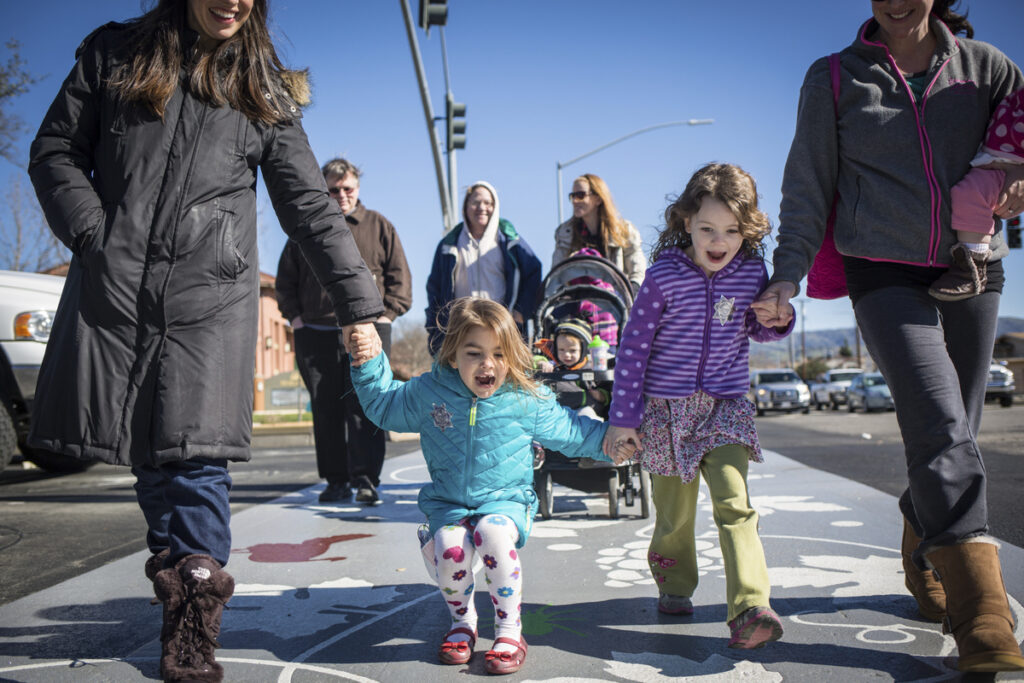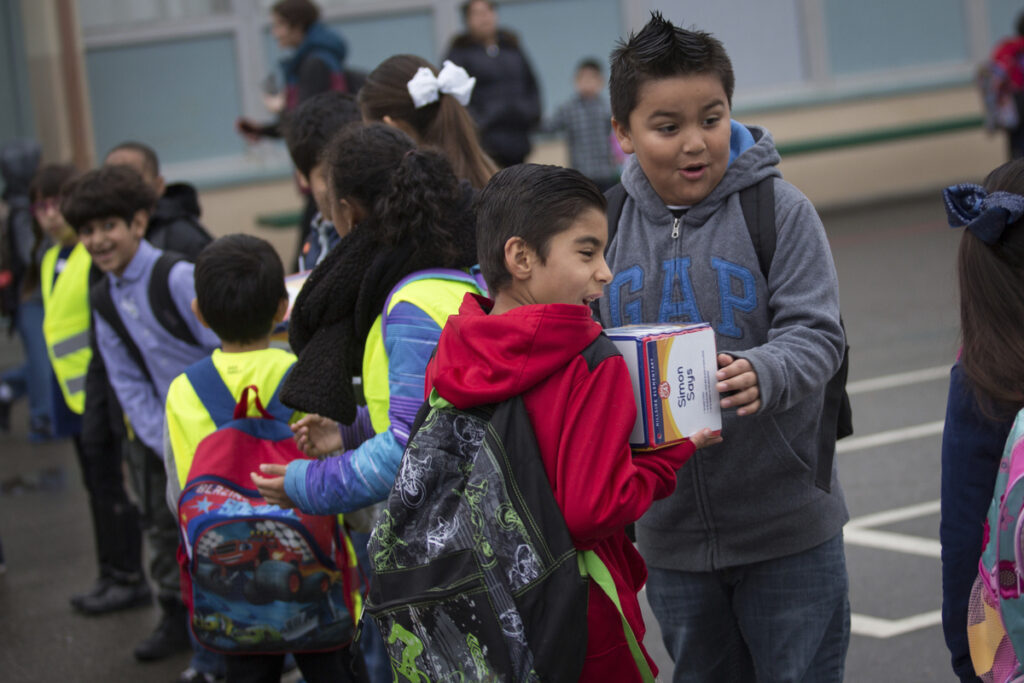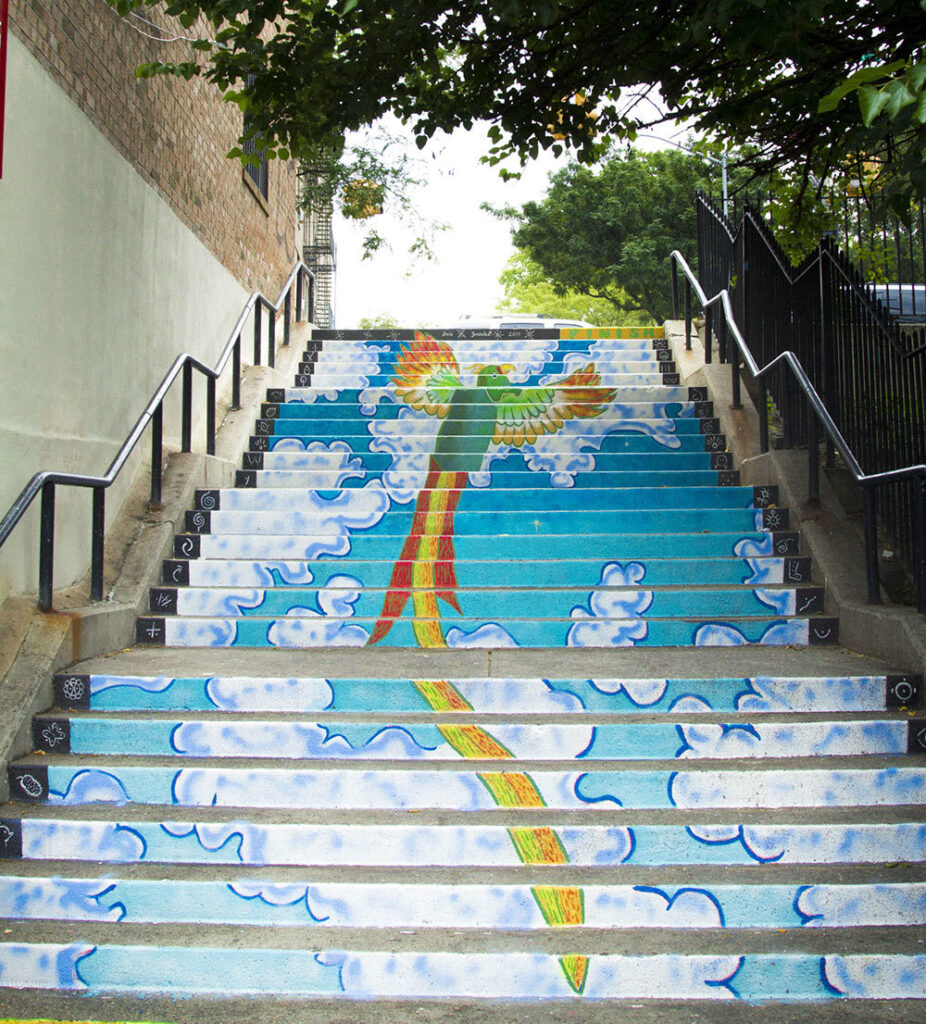The public right-of-way is crucial to fostering Play Everywhere and kid-friendly cities. Streets and sidewalks—and, by extension, the pathways, alleys and staircases that bisect city blocks—form the faces and front (or back) doors of our communities. These are the places where we interact and conduct the business of daily life, and where kids come into contact with, learn from and learn how to navigate the adult world. Reclaiming streets, sidewalks and mid-block connections as places for play brings kids front and center in our communities, while serving as a reminder to the broader community that cities are places for kids, too.

Design principles
Streets, sidewalks, and other public rights-of-way offer myriad spaces and opportunities for play. To visualize the range of opportunities for Play Everywhere, it is useful to focus on each of the individual zones and spaces that comprise a street, sidewalk and city block.
On the street
Though streets serve as places for vehicular traffic, there are numerous opportunities to reclaim portions of “street space”—the space between the curbs—for play. Cities and communities can:
- Animate crosswalks and intersections with playful visuals, such as murals and decorative elements. This not only encourages play, but also highlights pedestrian space, slows down traffic, and signals that kids live and play along the street.
- Repurpose on-street parking lanes as parklets, or public spaces created in the space previously occupied by one or more on-street parking spaces.
- Reimagine dead-end streets, cul-de-sacs, or other low-traffic streets as in-street playspaces during the long stretches of time that they are not used by automobiles.
- Incorporate play opportunities as part of traffic calming measures, such as curb extensions, roundabouts and traffic circles or medians.
- Create play streets and festival streets through temporary closure of streets—even major thoroughfares—at regularly-scheduled times, to create large, safe spaces for a variety of play opportunities.

Outside the curb
Each of the many zones and spaces that comprise the streetscape, from the sidewalks themselves to the edges of the streetscape adjacent to the streets and buildings, offer opportunities for play. Cities can integrate playful experiences into streetscapes by:
- Enlivening the pedestrian through-zones of sidewalks with painted murals and games on the pavement, or provide places for kids to make their own chalk art. Where excess space exists along a particularly wide sidewalk, a portion of sidewalk space could be devoted to play, while still accommodating pedestrian travel.
- Incorporating a range of play opportunities into the planting and furniture zone that separates the main sidewalk from the curb along many city streets. Located outside the zone where pedestrians travel, these areas often include shade trees and may be wide enough to accommodate seating and other street furniture.
- Utilizing building setbacks and “shy zones” as spaces for play installations. Where setbacks from the sidewalk are deep, these spaces between the sidewalk and building fronts can accommodate larger-scale play installations. In other contexts, particularly along urban main street environments where buildings are located close to the street, only a narrow space may exist between the fronts of buildings (sometimes referred to as the “shy zone”). Though narrow, these spaces are often wide enough to house a small play installation, without obstructing pedestrian travel. Along residential streets, playful features placed in front yards near the sidewalk, such as signs or yard sculptures, can also inspire play close to home.
- Repurposing large expanses of sidewalk at street corners. On some city sidewalks, particularly where the curb has been extended to enhance pedestrian crossings, sufficient space may exist between the curb and building corners for a play installation without obstructing pedestrian travel.
- Installing wayfinding and informational signs that invite kids to play, reinforce the street’s playful vibe, direct families to play opportunities and signal to adults and passing motorists that “kids are welcome to play here.”
- Animating building façades and windows with murals, games and other playful elements painted or attached to the façade.
- Creating a family of playful street furniture that adds whimsy to a walk down the street, at kids’ eye-level. For example, turn trash cans into painted wonders or amusements, or install benches and bike racks with playful designs.
- Programming play into the sidewalk experience by organizing playful walking school bus programs, which provide kids with safe—and fun—ways to get to school.
In-between spaces
Along city streets, many leftover spaces—the afterthoughts of buildings and transportation infrastructure—are overlooked or avoided, yet offer untapped potential for play. Some spaces, such as blank and windowless building façades, walls and fences, are simply uninviting or overlooked. Others, such as the spaces underneath bridges, may function as both physical and psychological barriers between neighborhoods because they appear secluded, unattractive and unsafe. Opportunities for reclaiming such “in-between” spaces include:
- Transforming the underutilized space beneath highway or railroad overpasses. Creative and playful makeovers of these spaces not only make them more inviting, but can go a long way toward removing the barriers that exist in the built environment. This can also transform “divider” spaces between neighborhoods into gathering places that unite communities.
- Reimagining blank and windowless walls as community canvases—or murals—filled with games, whimsy or neighborhood narratives.
- Integrating activities and playful visuals into fences, so that these barriers now beckon kids rather than keep them out.
Mid-block passages
On some city blocks, a variety of mid-block passages, including service alleys, mid-block pathways, and staircases, serve important functions for municipal utilities and services, while connecting people and vehicles more efficiently to their destinations. Yet these spaces are often afterthoughts and hidden from public view because they are not pleasant to navigate. With some imagination, however, these mid-block spaces also have the potential to knit together city blocks by serving as community gathering places, spaces where kids can play without coming into contact with the traffic from adjacent streets and fun routes for walking and bicycling. By taking advantage of mid-block passages, cities can:
- Activate mid-block alleys with light, paint, games, or play equipment. By temporarily or permanently closing an alley to traffic, it can serve as a playspace or a place for neighborhood events. An alley can also be permanently transformed into a shared street or woonerf that allows vehicular access, but prioritizes walking and bicycling—and playing.
- Incorporate mini-play destinations or playful design treatments along mid-block pathways, to make them more inviting shortcuts between destinations.
- Animate long, tiring staircases with art and whimsy to make the climb joyful rather than onerous.

General considerations
- Identify routes with high levels of existing pedestrian activity, such as routes to schools, commercial areas and other focal points of daily activities.
- Assess traffic volumes, traffic signals and overall parking capacity along a street to identify opportunities or constraints: What is needed for people to feel safe playing in a high-traffic area? Does a playful crosswalk require changes to signal timing? Are all on-street or garage parking spaces utilized during the day?
- Inventory underutilized and excess spaces that can be put to better use, as well as those that are unattractive, monotonous or feel unsafe. In which locations could an especially wide sidewalk accommodate other activities? Where are the underutilized building and pavement surfaces that could serve as a blank canvas for murals? Make note of the streets and spaces that serve as physical or psychological barriers within the community. How can unfriendly spaces and dividers be transformed into unifying spaces that bring communities together?
- Consider adjacent land uses along a street to identify complementary uses and partners. Locate Play Everywhere installations close to libraries, schools, community centers and other areas where kids spend time.
- Look for synergies in which Play Everywhere installations can help solve other transportation or built environment problems, such as traffic safety issues, lack of physical activity, crime, poor community character and image.
- Minimize conflicts with other street and sidewalk functions, such as traffic and pedestrian flow, drainage, utilities, service and loading access, emergency access and snow removal by selecting locations that pose the least amount of conflict with other users and activities within the right-of-way.
- Expand play opportunities through programming by leveraging and complementing Play Everywhere installations with temporary street closures, play streets or festival streets and a variety of programmed entertainment and events.
- Ensure accessibility for all ages and abilities. Make sure that the playspace can accommodate walkers, wheelchairs and strollers, and that all users, regardless of age or ability, have the opportunity to engage in play. Incorporate seating, such as benches, so that adults can comfortably watch and participate in the play experience, while enhancing the streetscape in the process.
- Consider ownership and maintenance. Understand where public space ends and private property begins, who will be responsible for maintaining the play installation after it is built and the durability and upkeep required of the installation’s materials.
- Embrace trees and greenery. Leverage existing street trees to provide shade, a buffer from passing cars and incorporate landscaping where feasible to enhance the streetscape and provide opportunities to connect with nature.
- Strive for maximum visibility. When selecting a location for a Play Everywhere installation, make sure to understand the views along a street that will maximize visibility to potential users (for example, is the playspace obscured by trees or topography or bends in the road?). Incorporate vibrant colors, lighting and other identifying features into the design of the installation to beckon kids and families from a distance. If an installation is located in a mid-block location, consider incorporating wayfinding elements, such as signs or painted footsteps on the pavement that direct people to the playspace.
- Make it a “play trail” by linking individual play opportunities along a streetscape through the use of common design elements, such as painted lines on pavement or a family of signs or markers, to create a continuous play experience.